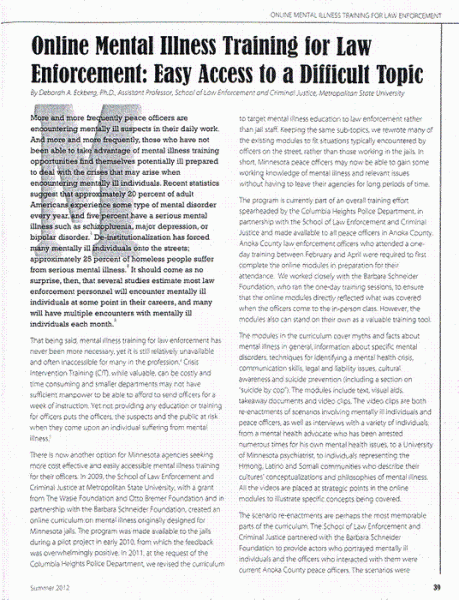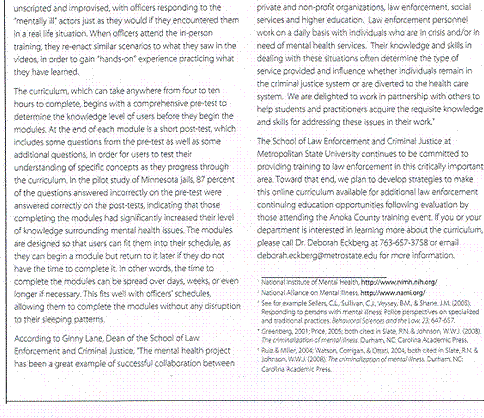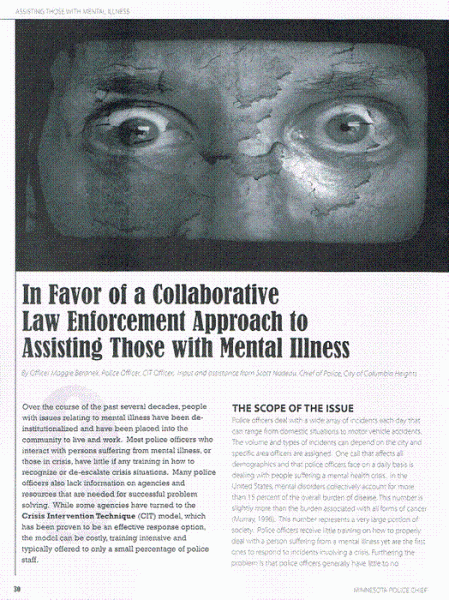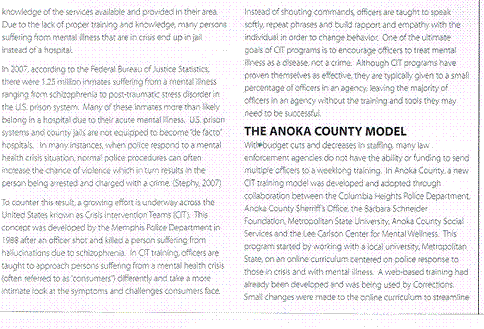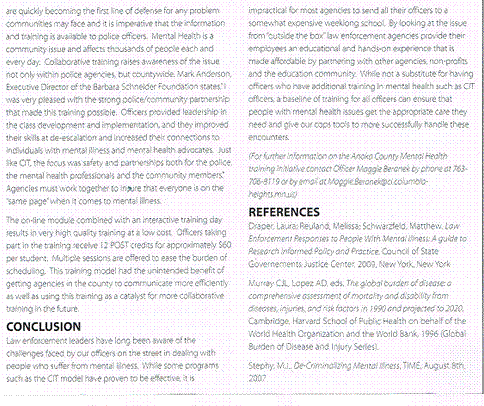Archive for the ‘Articles’ Category:
Youth Trauma Linked to Later Ills
Article by: JEREMY OLSON , Star Tribune
Survey: Childhood stress can increase disease, anxiety and drinking in adulthood. Stress and trauma in childhood tend to lead to anxiety and poor health in adulthood, according to Minnesota’s first-ever survey of adults about “adverse experiences” in their youth.
More than half of the 13,520 Minnesotans reported at least one traumatic experience in their childhood, including physical abuse, parental divorce or the incarceration of a household member. Those who reported multiple events had higher rates of chronic diseases such as asthma and mental disorders such as depression.
“They’re at the heart of many of the leading causes of death and disability,” said Dr. David McCollum, who works in the injury prevention unit of the Minnesota Department of Health.
The department released the data Monday, making Minnesota the 18th state to survey adults about youth trauma. The survey builds on research by the U.S. Centers for Disease Control and Prevention showing that traumatic events in childhood can cause toxic levels of stress that actually alter children’s brain chemistry. Other research has correlated such childhood events with suicide, unintended pregnancies, illicit drug use and sexually transmitted diseases.
“Stress becomes hard-wired in the body, and that is expressed throughout life,” said Laura Porter, former director of the Washington State Family Policy Council. Her state was among the first to study the relationships.
Verbal abuse was the most common among the nine categories of childhood events in the survey, followed by living with someone who has a drinking problem. One in 10 respondents reported sexual abuse in childhood and one in seven reported physical abuse. McCollum said the type of events didn’t matter; the higher the number, the more likely they were to correlate with problems in adulthood.
One in four Minnesotans in the survey reported four or more adverse experiences. They were twice as likely to be chronic drinkers and at least five times as likely to suffer anxiety.
The research doesn’t prove that childhood traumas cause adulthood problems, only that there is a statistical relationship. These experiences also had a profound link to overall well-being, said the Health Department’s Pete Rode, and were associated with a higher likelihood of dropping out of high school, being unemployed or worrying about paying for rent and food.
Research on the impact of childhood experiences began in the 1990s with a California doctor who wondered why some adults were dropping out of his otherwise successful weight-loss program. A review of medical records showed strong correlation with problems in childhood.
Porter said the research in Washington gave parents a new appreciation of the power of childhood experiences. Some parents revamped the way they treated their children; neighbors often showed more compassion to people with traumatic upbringings.
One concrete change in Washington was alternative sentencing for mothers convicted of nonviolent crimes, so they could raise their children and prevent the severe stress of separation.
Minnesota’s report recommended no such specific changes. It urged a similar effort to raise public awareness, along with financial and other resources to deal with the lingering problems of childhood trauma.
McCollum said the findings do not mean that someone has an unchangeable “destiny” just because of problems in youth. It does mean the state needs to understand the risk factors and help children and adults cope, he said. People can’t just say, “Time will heal things. Just put it behind you. Pull yourselves up by your bootstraps,” he said. “It doesn’t work.”
Jeremy Olson • 612-673-7744
Share of Minnesotans who reported childhood exposure to:
- Household member – 7% incarcerated
- Sexual abuse – 10%
- Physical abuse – 16%
- Mental illness – 17%
- Problem drinking – 24%
Source: Minnesota Department of Health
Violence Prevention
A Commentary Statement jointly developed by
The Minnesota Psychiatric Society, The Barbara Schneider Foundation
SAVE – Suicide Awareness Voices of Education
Minnesota is not immune from individual or mass violence. The last mass shooting in this state was March 21, 2005, at Red Lake where 9 people were murdered, 5 wounded and 1 died by suicide. The recent violence in Arizona is an important reminder to us of the challenges and opportunities that we have in better responding to members of our communities who live with severe mental illnesses.
The current budget challenges must not lead to further reductions in our already fragile mental health response system and capacity. Some have noted that in the Arizona county where the shooting occurred, nearly 50% of mental health recipients were removed from funding because of budgetary concerns and that the rate of suicide attempts, hospitalizations and law enforcement encounters had all gone up. This is the wrong path to take and as citizens we need to ensure our legislators understand this to protect Minnesotan’s and those who visit our state. We must create more entry points to the mental health system and make them more accessible. According to the Minnesota Department of Human Services, less than half (only 36 out of 87 counties) provide mental health crisis services. Most hospitals lack psychiatric services and even hospital security. This is a problem that needs to be addressed now, before another Red Lake or Tucson tragedy occurs. Appropriate mental health crisis response training needs to be conducted in hospitals and for law enforcement the Crisis Intervention Team (CIT) model trains officers how to respond to mental health crises. This model was introduced in Minnesota 10 years ago and has proven effective, yet although several police and sheriff agencies are adopting this model and training CIT officers and 911 dispatchers, most public safety agencies in Minnesota have yet to train their officers in CIT. To fully protect our state, legislators must endorse and support this important public safety training.
The evidence suggests that many of the people involved in mass shootings have alcohol and drug problems and psychotic symptoms. In addition, their social behavior leads to isolation and conflict at home, school, and work. They often have contacts with law enforcement because of behavioral problems. Family members and coworkers are often at a loss in communicating with them and helping them. Systems available for crisis intervention are not consistently available and the best pathway of care is not always applied. Families are often left dealing with a developing crisis and cannot get help.
This is a public health and public safety issue. We need to approach this as we would other public health issues by preventing the crisis.
We believe that the best approach to addressing these incidents is to make them a priority and determine what can be done to prevent them. This includes:
- Mobilizing existing resources that are frequently not used prior to the incident, including the consistent application of public education about violence and aggression as possible symptoms of some mental illness, legal interventions including CIT, and psychiatric treatment.
- Increasing access for individuals with severe mental illnesses to quality psychiatric care and support in the communities where they live.
- Redefining quality psychiatric care for symptomatic individuals with aggressive behavior and violence.
- Establishing a national database of incidents for further research on the problem.
We can take concrete steps to reduce the chance of violence. Let’s make it a priority.
Minnesota Psychiatric Society
George Dawson, MD, F.A.P.A
President
Barbara Schneider Foundation
Mark Anderson, Executive Director
SAVE – Suicide Awareness Voices of Education
Daniel J. Reidenberg, PSY.D., FAPA
Executive Director
RUBEN ROSARIO: SHE SAW NEW ORLEANS’ DARKEST DAYS – AND STILL FOUND HOPE
By Rubén Rosario Updated: 04/03/2010 08:44:16 PM CDT

Cecile Watters Tebo was battling her own torments when she ‘rolled up’ — as she is fond of saying— at the scene of a suicidal man about to jump from a bridge.
With her flooded, mold-plagued home lost to Hurricane Katrina and facing homelessness in a few days, the 50-year-old mother of three knew she was in the midst of a “dark, deep, paralyzing” depression. Now, as the civilian head of the New Orleans Police Department’s mobile crisis unit, the only one of its kind in the nation, she was facing a man who had lost all hope.
“He was holding an umbrella, and he looked at me with earnest eyes that said: ‘Please, just let me go,’ ” recalled Tebo, a former social worker, ex-debutante and member of a well-heeled and well-established New Orleans family.
“I wondered if I was being hypocritical at taking his hand, because at the time, I was thinking, how in the world do I do my job when my own world is falling apart, while I’m trying to uplift other people who are feeling hopeless and helpless?”
There was a fleeting second where Tebo thought about perhaps joining the man and taking the plunge. But she reached out to comfort and provide refuge.
“Baby, we’re going to make this day better and brighter. Take my hand,” she said before the man grabbed it that winter day in 2005.
Tebo plans to share her experiences responding to the needs of the mentally ill before and after Katrina at a one-day conference Wednesday at the Minneapolis campus of the University of St. Thomas.
Co-sponsored by the Barbara Schneider Foundation — named after a mentally ill woman fatally shot by Minneapolis cops during a disturbance — the conference focuses on how to provide better mental health services to underserved communities.
Some look upon Tebo as the Big Easy’s Florence Nightingale when it comes to the way she has dealt with mentally ill people whom police and her unit encounter daily.
“Tebo is on fire with her passion for treating those with mental illness and those in crisis with the greatest dignity,” said Mark Anderson, the foundation’s executive director. “She is undaunted by the enormous challenges that postKatrina New Orleans presents to the 911 responders and the whole community there.”
Katrina claimed far more than 1,800 lives while laying waste to brick and mortar. The area’s suicide rate tripled after Katrina. Half the city’s adult population struggled with “clinically significant psychological distress” seven weeks after the storm, according to the U.S. Centers for Disease Control and Prevention.
Another study found that the percentage of Gulf Coast residents with mental health problems had shot up to 31.2 percent a year after the hurricane struck the region.
If that wasn’t bad enough, New Orleans had just 10 public and private hospitals with only 400 psychiatric beds. As of last year, the number of beds reportedly dipped below 170 while demand was steady.
Tebo’s unit, which dropped from 40 volunteers to single digits during the storm, faced resistance and hostility from already-swamped emergency rooms that wanted little to do with psychotic and mentally ill patients.
“By federal law, ERs cannot refuse treatment to anyone who walks in,” Tebo said. “But at times, some of them, knowing we were coming with these people, actually met us on the ramp so that they would not have to take them in. I had to fight at every place just so they could be seen and treated.”
The situation, worsened by the recession and municipal budget cuts, “still remains pretty bad,” Tebo said.
In fact, her anguish at the bridge that day five years ago stemmed from two realizations: Even if they saved the man, where would they take him? And if they found a facility, would he receive proper treatment?
Throw in the then-recent death of her three sons’ beloved pediatrician and close family friend. The middle-age physician’s practice was wiped out by the storm while he was also dealing with physical ailments. He hanged himself in his home.
“He was a beautiful, precious man,” Tebo said.
The burden proved too much. Tebo, curled up in bed, was knocked out of service for some five days.
Then, not unlike the reeling and wounded city of her birth, she slowly began to tap into her faith and resilience and pull herself back up. As bad as things were, other people were in more pain, she thought. She sought help and eventually returned to the streets.
The granddaughter of a 1940s New Orleans police chief, Tebo wanted to be a cop since childhood. But that aspiration was detoured after she cared for disabled children at a hospital in her teens and pledged to help the less fortunate.
She entered social work and worked in the adoption field until the police bug bit again. She enlisted as a volunteer at the age of 40 with the city’s police reserves program. It was there she learned about the mobile crisis unit, formed in the 1970s and still unique among the nation’s police departments. She had no problem trading a service handgun for the brown leather and Velcro restraints she and unit members use on the job.
The unit responds to nearly 250 emergency calls monthly, and its volunteer membership consists of people “from all walks of life,” Tebo said. Volunteers cannot respond unless police officers are at the scene.
Tebo strongly believes mental illness remains very much a stigma and a low priority.
“It has been very clear to me that it is not even on the radar in the medical field, and it’s going to get the last attention in a major emergency,” Tebo said. “It should be just the opposite.”
Although she has been punched and kicked and injured during encounters with those in crisis, Tebo considers what she has done the past decade the “coolest job in the whole wide world.”
“When I roll up on people in a psychotic state and they are covered in urine or feces and no one wants to touch them, I can’t wait to get my arms around them because I truly believe they are God’s angels,” she said. “Their life has meaning. They remind us of what we have and should appreciate and why we should be willing to give them our hand.”
This report includes information from the Washington Times.
Rubén Rosario can be reached at 651-228-5454. or rrosario@pioneerpress.com.
Why Juvenile Detention Makes Teens Worse
TIME Magazine www.time.com
Friday, Aug. 07, 2009
By Maia Szalavitz
Parents have always warned teenagers against falling in with the wrong crowd, those kids they consider bad influences. Now a new study of juvenile detention in Montreal adds to the evidence that Mom and Dad may have a point.
Researchers found that rather than rehabilitating young delinquents, juvenile detention — which lumps troubled kids in with other troubled kids — appeared to worsen their behavior problems. Compared with other kids with a similar history of bad behavior, those who entered the juvenile-justice system were nearly seven times more likely to be arrested for crimes as adults. Further, those who ended up being sentenced to juvenile prison were 37 times more likely to be arrested again as adults, compared with similarly misbehaved kids who were either not caught or not put into the system. (Read “Getting the Juvenile-Justice System to Grow Up.”)
“It’s much worse than we would have expected,” says Richard Tremblay, a psychology professor at the University of Montreal and a co-author of the study, which was published in the Journal of Child Psychology and Psychiatry. “By having them live together, they form relationships. It’s more likely to increase the problem.”
The 20-year study followed 779 low-income youth in Montreal with annual interviews from age 10 to age 17, then tracked their arrest records in adulthood. Researchers also interviewed the teenagers’ parents, schoolmates and teachers. The study accounted for variables such as family income, single-parent-home status and earlier behavior problems (such as hyperactivity) that are known to affect delinquency risk. (See pictures of crime in Middle America.)
Kids who entered the juvenile-justice system even briefly — for example, being sentenced to community service or other penance, with limited exposure to other troubled kids — were twice as likely to be arrested as adults, compared with kids with the same behavior problems who remained outside the system. Being put on probation, which involves more contact with misbehaving peers, in counseling groups or even in waiting rooms at probation offices, raised teens’ odds of adult arrest by a factor of 14.
The rehabilitation of troubled teens has long been a contentious issue, pitting the individual needs of problem children and families against a system that does not typically give social workers adequate tools or resources to help. Often, the treatment of difficult or drug-using teens occurs en masse — in residential homes, for example — but instead of scaring kids straight, the group experience tends to glamorize delinquency and drug use. (Read “Teens Behaving Badly?”)
Why? In any such setting, teens establish a predictable social hierarchy, says Tom Dishion, director of research at the Child and Family Center at the University of Oregon, who was not involved with the study. The kids who have behaved worse than others — committing robbery, for instance, vs. smoking cigarettes — earn the most credibility with their peer group, which encourages further bad behavior. “That story [about robbing someone] has a function of making that kid more interesting. He or she gets a lot of attention. [These kids] become higher in the social hierarchy.”
Says Tremblay: “There is that competition of who is going to do the worst stuff — for them, it’s the best stuff — like stealing the biggest or best car.”
Past research has also shown that peer exposure can worsen behavior. In a 1995 study conducted by Dishion involving 158 high-risk families in Oregon, researchers compared the impact on teens’ behavior of four interventions: parenting groups focused on effective discipline, social-skills-training groups for teens, both the parent- and teen-focused group interventions, or no group treatment at all. Overall, the parent-focused group was most effective, leading to reductions in teen smoking and misbehavior at school. The teen-focused group, by contrast, significantly increased participants’ rate of aggressive behavior and smoking; in the combination group, kids showed no improvement, presumably because the exposure to other teens canceled out the positive effect of the parents.
The new study supports these findings, suggesting that family therapy or one-on-one counseling — or any intervention that doesn’t aggregate troubled teens — is safer and more likely to be effective than group activities. But if groups must be used, experts say that high supervision and low child-to-staff ratios are essential to minimize the risk of behavior contagion.
“I think it’s a very important finding, and it’s consistent with other research in the last 10 years on this topic,” says Dishion. “What’s really surprising is that we don’t have more research showing this to be true. Almost everyone you tell about these findings who has worked in [residential or juvenile-justice settings] is not surprised. I think there’s a tacit agreement not to look too carefully.”
Study: Mental health courts showing positive results
Please click on the following link to read/listen to the coverage:
http://minnesota.publicradio.org/display/web/2009/07/17/mental_health_courts/
by Elizabeth Stawicki, Minnesota Public Radio July 17, 2009
St. Paul, Minn. — A New York-based policy research group says Hennepin County’s criminal mental health court is showing positive results.
Mental health courts are specialized courts that deal with people’s underlying mental health problems as well as their crimes. The aim is to reduce repeat offenses and increase compliance with outpatient treatment and medication.
Minnesota’s chief justice and the research group unveiled the findings Friday at the history center before an audience of judges, social workers, county commissioners and advocates.
Criminal mental health courts are relatively new; Hennepin County’s began only six years ago. Today, there are about 250 of them around the U.S. They began in response to what the justice system began seeing was a revolving door for the mentally ill.
People suffering from illnesses such as schizophrenia and bipolar disorder would commit property crimes or assaults. Police would arrest them; a judge would sentence them; they would do their time and be released, only to start the cycle over again. Through treatment, medication and intense supervision, mental health courts try to end that cycle.
Because mental health courts are relatively new, there’ve been few studies on how well they work. Minnesota Chief Justice Eric Magnuson said evaluating the courts is as important as having them.
“We do what we think is right, but we need to find out if our assumptions are correct,” Magnuson said. “Do we get the results that we hope to get? Here, the results are quite promising.”
“Here, the results are quite promising.” – Chief Justice Eric Magnuson
Through a MacArthur Foundation grant, New York-based Policy Research Associates studied four mental health courts in Hennepin County, San Francisco, San Jose, and Indianapolis. The research showed generally about a 20 to 25 percent improvement in the outcomes for offenders who went through mental health courts compared to those who did not.
For example, the research showed those who went through Hennepin County’s mental health court were, on average, likely to get arrested again in four months. Those who did not go through the specialized court got arrested again in less than three weeks.
Sociologist Henry Steadman, who heads the New York-based policy research group, said it’s important to view those numbers in context.
“Taking a hard-core, challenging population that has failed repeatedly in all three systems: criminal justice, substance abuse and mental health,” Steadman said, “and has cycled and is a particularly challenging group, and have come up with an intervention that is a 20 to 25 percent improvement on almost all the measures. My evaluation is that’s pretty damn good in today’s world.”
But at a time when county budgets are strapped for funding, mental health courts don’t show an immediate savings. The study’s findings show they actually cost a little more during a person’s first year in the program because that person is getting more services. Steadman said any savings don’t show up for about a year and a half, and that can be a tough sell to the community.
Richard Hopper, Hennepin County’s mental health judge, said he tells funders up front the program won’t save money immediately, but that it will use money more wisely. Hopper said many of the mentally-ill people who get in trouble with the law, especially the homeless, end up at hospital emergency rooms.
“Well what does it cost for an emergency room doc to prescribe a medication? Probably about $750,” Hopper said. “Well if they’re in mental health court and you’ve made an appointment for them to see a doctor at the mental health center, it probably costs about $150.”
Ramsey County also has a mental health court. County Commissioner Jim McDonough said the presentation reinforced his support of such courts, but he questioned whether overall they will ever save money. He said their value is in a safer community and a better quality of life:
“Great cost savings on an individual basis, but on a system-wide basis I’m not so sure that there’s going to be a true cost savings to the taxpayer other than we’ll be able to be providing more humane and appropriate treatment for people with mental health within the criminal justice system,” McDonough said.
The study is in a second phase that will compare the actual costs and benefits of mental health courts with typical criminal courts.
Broadcast Dates
All Things Considered, 07/17/2009, 4:49 p.m.
Mental health study: Income inequality, no respect, justice drives us nuts
By Sam Pizzigati
Editor, Too Much
WASHINGTON—Many Americans, says new polling from the Pew Charitable Trusts, don’t see inequality as a particular problem so long as society offers everyone an “opportunity” to get ahead. These Americans just might feel a bit differently if they had a chance to chat with the analysts behind a stunning new survey of the latest global research on mental health. Mental Health, Resilience and Inequalities, prepared for the World Health Organization European Office by Dr. Lynne Friedli, in conjunction with the Mental Health Foundation, London, reports that income inequality may be driving people nuts.
Back in the 19th century, amid choking levels of infectious disease, scientists and eventually political leaders came to realize sewers and clean water could actually keep people healthy far better than any medical potion. Now here in the 21st century, amid the scourge of heart disease and other degenerative conditions, we may once again be poised for another great conceptual leap. We still, of course, need those sewers and that clean water. But we need something else, suggests this new report. We need respect and justice.
That’s not a message we normally expect to hear from mental health professionals. We tend to think about mental health, after all, as a matter of individual pathology — and we tend to separate mental from physical health.
The distinguished mental health professionals behind this report don’t make that separation. They link mental health to the diseases that ravage our physical health — and tie both mental and physical health to levels of social and economic injustice.
Our “individual and collective mental health and wellbeing,” as Mental Health, Resilience and Inequalities pronounces, “depends on reducing the gap between rich and poor.” Read that sentence again, and think about its implications.
The British Mental Health Foundation backs this pronouncement up by walking us through a wide-ranging array of recent international medical research. “People with mental health problems,” research tells us, “have much higher rates of physical illness.”
Smoking, most of us understand, increases the risk of suffering cardiovascular disease. But researchers have documented that “the absence of positive mental health” will put you at greater risk for cardiovascular disease than smoking.
Mind over matter? Stress over immune system might be a better formulation. Chronic stress beats down our body’s defenses, upsets our physiological balances, leaves us open to disease.
What stresses us? Living in poverty, for starters. Coping with deprivation and disadvantage, day in and day out, wears us out. But stress doesn’t just come from eprivation, trying to make do without the material basics of life. Stress comes,
perhaps even more powerfully, from inequality, from the constant pressures that come with life in deeply divided societies, the foundation-backed report says.
“The adverse impact of stress is greater in societies where greater inequalities exist, and where some people feel worse off than others, it adds.” This stress impacts everyone, not just the poor. Deep-seated inequality heightens status competition and status insecurity across all income groups and among both adults and children.”
The reverse also holds. The smaller a society’s economic divides, the less stress, the more health.
“Both high and low income populations,” points out Mental Health, resilience and Inequalities, “benefit in more equal societies.”
This Mental Health Foundation analysis goes on to detail how the dynamics of unequal societies play out, with a level of medical specificity readers outside the health professions may sometimes have trouble digesting. But if your eyes don’t glaze over when the discussion turns to “C-reactive proteins,” you’ll have no trouble navigating your way.
And even those of us who stumble over “neuroendocrine” pathways and “bio markers” will find plenty of value — and even inspiration — in these pages. We can become more healthy, the Mental Health Foundation reminds us, because we can become more equal.
“This is not about utopian visions,” the foundation sums up. “The comparison between Sweden and the United Kingdom shows that relatively small differences in levels of inequality can have very significant effects on health.”
Courtesy of Labor World, April 1, 2009
Making the case for treatment: Details on the interface between a local care system and the criminal justice system
by Kate K.V. Lawson, MPA; Michael R. Berren, PhD; and Neal Cash, MS
Behavioral Healthcare
The situation is not uncommon: A family member of an individual with a mental illness calls local law enforcement as a “last resort.” A situation has escalated to the point of being a crisis and, for everyone involved, it appears as though all other options have been exhausted. While the call is generally a last-ditch effort to ensure safety for the individual and/or others, law enforcement’s presence often results in the individual with a mental illness being arrested or detained. In addition to this scenario, it is not unusual for individuals with a mental illness to become involved in the criminal justice system for crimes that often are a consequence of their illness and/or social situation (such as vagrancy because the individual often has nowhere else to go). They then must manage the difficult task of negotiating a complicated criminal justice system while attempting to reengage in treatment. The criminalization of mental illness is hardly a new topic. It has been written about for decades, with an article by Abramson (1972) being one of the earliest.1 Following Abramson’s article have been hundreds of others addressing the issue of jails and prisons becoming primary housing facilities for individuals with mental illness. Not only is it a topic of concern for professional publications, the criminalization of people with mental illness regularly is addressed in the popular press. For example, a March 3 blog post on the Dallas Morning News Web site talked about a bill that would prevent local authorities from using “time and convenience” as reasons for incarcerating mental health patients.2 There are a myriad of reasons, however, why using the criminal justice system as a de facto mental health system is inappropriate, including the following. R26; Jails and prisons are ill-equipped to serve as mental health facilities. Where statistics are available, inmates with mental illness have higher than average disciplinary rates. A study in Washington State found that while inmates with mental illness constituted nearly 19% of the state’s prison population, they accounted for 41% of infractions.3 This leads to the additional issue of inmates with mental illness who have problems with controlling their behavior being disproportionately placed in solitary confinement. Furthermore, solitary confinement is particularly difficult for inmates with mental illness because of limited medical care and the psychologically harmful consequences of isolation and idleness.
- While in detention medications may be discontinued or changed, and the variety of case management, skill building, and clinical services will be limited or eliminated completely.
- Incarceration is an expensive alternative to treatment. While prison can cost quite a bit more, even incarceration at the Pima County (Arizona) jail can cost nearly $100 per day.
- Once an individual’s treatment has been interrupted by incarceration it can be difficult to reengage him/her in services, thereby adding to the long-term costs.
- In addition to the costs to taxpayers and adverse impact on the individual, it is unethical to use incarceration and prison as an alternative to treatment.
Our response
Given all of the reasons for not wanting to inappropriately incarcerate individuals with mental illness, the Community Partnership of Southern Arizona (CPSA) collaborated with its provider network and the criminal justice system to form the Behavioral Health/Criminal Justice System Workgroup. The workgroup’s first task was to identify systemic issues that led to inappropriate incarceration and/or inappropriate length of stay. Following the identification of issues the workgroup began to focus on the strategies and interventions that could be implemented to reduce the time that an individual with a mental illness is inappropriately incarcerated. That is not to say that incarceration is always inappropriate. There are a variety of circumstances in which incarceration might be appropriate to protect an individual from being a danger to him/herself or others, or serve as an intervention before more serious destabilization occurs. Furthermore, incarceration may become a “wake-up call” for the individual as to the consequences of not properly managing his/her illness. One of the workgroup’s primary outcomes was creating the CPSA Criminal Justice Team, established to be a resource and link between the justice and treatment systems. The team works with behavioral healthcare provider agencies (each of which was mandated to employ a criminal justice specialist) and other stakeholders, such as courts, probation officers, pre-trial services, the jail, police departments, and attorneys, to facilitate resolutions of both system-wide and member-specific issues. To have a positive impact on inappropriate incarceration, the collaborative relationship between the various behavioral healthcare and justice entities must allow for information to pass quickly and efficiently, while at the same time observing applicable HIPAA rules and regulations. Contrary to popular belief, HIPAA rules do not necessarily have to be a barrier for communication between criminal justice and behavioral healthcare agencies. Rather, it can provide tools to aid in cross-system information sharing. For example, when an individual is detained in the jail, time is of the essence in transmitting critical behavioral healthcare information from the treatment provider in the community to the treatment provider in the jail. Failure to do so can result in further destabilization and crisis for the individual, thereby increasing risk of injury to the individual (including suicide), other inmates, and jail staff.
Collaborative strategies
The three most commonly used tools to share CPSA member-specific information within the Criminal Justice Team includes the following.
Provider-to-provider information sharing. To identify in real time clients who have just been arrested, twice a day the “booking list” of the county is filtered against the CPSA member roster. When a match is identified the Criminal Justice Team sends a notification to the criminal justice specialist at the behavioral healthcare agency, notifying him/her that a client in his/her network has been arrested. This real-time notification includes the charges, the client’s enrollment status within the behavioral healthcare system (SMI, substance abuse, etc.), the assigned court or jurisdiction, and the next court date. The Criminal Justice Team also notifies the contracted healthcare provider at the jail that an inmate in its custody is enrolled in the community behavioral healthcare system. A recent enhancement to the Criminal Justice Team initiative is to have a CPSA criminal justice team member attend the initial appearance court hearings (at which a judge determines conditions of release, if any, and informs the individual of the charges). The team member’s participation allows for:
- A universal consent form (discussed below) to be signed
- An assessment to determine the individual’s ability to transport him/herself home and to treatment
- Information sharing with pre-trial services and the presiding judge
For individuals not enrolled in the treatment system, the criminal justice team member facilitates the enrollment process and timeliness of having the person seen by a treatment provider. This recently implemented process has significantly increased the likelihood that the individual may avoid being taken into custody. If a CPSA-enrolled member is taken into custody, CPSA provider agencies are contractually required to submit to the jail healthcare provider clinical information, including medications the individual is taking, case management notes, and any other information deemed relevant. CPSA’s pharmacy staff also send the most recent pharmacy information to the jail’s healthcare provider. The jail healthcare provider, in turn, places individuals with mental illness on a specialized caseload, which allows them to be housed in acute or subacute mental health “pods” within the jail, if needed. On a weekly basis the CPSA Criminal Justice Team members, the behavioral healthcare agencies’ criminal justice specialists from, and the mental healthcare provider meet to discuss general issues and conduct staffing and discharge planning for inmates enrolled in the behavioral healthcare system. Individuals who have been identified as having a mental illness but not enrolled in CPSA may be referred/evaluated for enrollment while in custody. The team may coordinate transportation for individuals too unstable to leave the jail unassisted or assessment for court-ordered treatment for those who meet the legal criteria of danger to self, danger to others, persistently or acute disabled, or gravely disabled.
Universal consent form.
The Criminal Justice Team developed and implemented use of an information-sharing universal consent form accepted by all providers in the CPSA system and readily used by all criminal justice entities, including court officials, attorneys, probation officers, and law enforcement. While a consent form is not required for all information-sharing activities (e.g., as ordered by a judge or to the healthcare provider at the jail), using the form not only establishes a recognition for the individual’s privacy, but also lets the individual know of every agency with whom his/her information will be shared and for what purpose. The form permits the Criminal Justice Team and providers to share real-time information, which may change daily depending on the person’s stability and criminal case processing. It also permits communication with multiple justice entities when cases are pending in more than one court or jurisdiction.
Mental health courts and judicial orders.
A standardized judicial order for sharing healthcare information typically is used in the specialty mental health courts by judges who have received behavioral health training and understand these orders’ legal and medical implications. Standardized orders permit a level of sharing and collaboration that is even greater than allowed through the universal consent form. CPSA co-sponsored mental health courts are examples for how collaboration between various social service and criminal justice entities benefits the stakeholders, community and, most importantly, the CSPA members. CPSA has active mental health courts in five jurisdictions, as well as a consolidated justice court and felony superior court. Members enrolled in a mental health court have been found to be more compliant with treatment, resolve criminal charges more efficiently and effectively, and commit fewer new offenses. These outcomes result in improved public safety, cost savings to taxpayers, and better outcomes for our members.
Systemic strategies
HIPAA-compliant mechanisms for sharing member-specific information is only part of the process used by the community to make the most appropriate use of the criminal justice system as it concerns mental health patients. There are also a number of strategies to impact system-wide issues. Other collaborations that CPSA coordinates, or is an active participant in, include: • Pima County Forensic Task Force
- Mental health court steering committee
- Crisis intervention training with law enforcement
- Court-specific collaborative committees As a result of these collaborations, Southern Arizona has developed standards and ethics that value progressive programs that positively impact individuals with mental illness involved in the criminal justice system.
Kate K.V. Lawson, MPA, is the Criminal Justice Manager at the Community Partnership of Southern Arizona (CPSA), the regional behavioral health authority coordinating and managing publicly funded behavioral health services in Cochise, Graham, Greenlee, Pima, and Santa Cruz Counties. Michael R. Berren, PhD, is CPSA’s Director of System Development and a clinical lecturer in the Department of Psychiatry at the University of Arizona. Neal Cash, MS, is President/CEO of CPSA. For more information, e-mail michael.berren@cpsa-rbha.org.
References
1. Abramson MF. The criminalization of mentally disordered behavior: possible side-effect of a new mental health law. Hosp Community Psychiatry 1972;23(4):101-5.
2. Ramshaw E. Keeping mental health patients out of jail [blog post]. Dallas Morning News. March 3, 2009. http://trailblazersblog.dallasnews.com/archives/2009/03/keeping-mental-health-patients.html.
3. Fellner J. A corrections quandary: mental illness and prison rules. Harvard Civil Rights-Civil Liberties Law Review 2006;41(2):391-412. http://www.law.harvard.edu/students/orgs/crcl/vol41_2/fellner.pdf
Articles & Archives:
• Working to reunite families torn apart by mental illness
• Training video helps police work with mentally ill youth
• Learning from the ‘drama’ of police encounters
News:
• Study documents prevalence of serious mental illnesses among nation’s jail populations
• Guide examines law enforcement responses to people with mental illnesses
• Mental health court program honors Centerstone employee
• NIDA study shows prisoners are not receiving drug abuse treatment
• Council of State Governments releases primer on mental health courts
A Guide to Emerging and Promising Crisis Intervention Programs for Youth
NAMI, 2107 Wilson Boulevard, Suite 300
Arlington, VA 22201‐3024
Web site: www.nami.org
Telephone (703)‐524‐7600 or (800) 950‐NAMI (6264)
Supporting Schools and Communities in Breaking the Prison Pipeline:
A Guide to Emerging and Promising Crisis Intervention Programs for Youth
Dana Markey, Program Coordinator, NAMI Child and Adolescent Action Center
Laura Usher, Coordinator, NAMI Crisis Intervention Team (CIT) Resource Center
Darcy Gruttadaro, Director, NAMI Child and Adolescent Action Center
Ron Honberg, Director, NAMI Policy and Legal Affairs
Acknowledgments
NAMI deeply appreciates the support of the Annie E. Casey Foundation for this project. We acknowledge that the information, opinions, and commentary in this guide are those of NAMI, and do not necessarily reflect those of the Casey Foundation. To learn more about their work, visit www.aecf.org. We also wish to express our appreciation to the many individuals who are leading this field, and who shared their time and expertise with us, including: Keri Fitzpatrick, Sergeant Jon Van‐ Zandt, Carol Peters, Terri Mabrito, Lieutenant Jeffry Murphy, Officer Kurt Gawrisch, Stacie Golden, Oscar Morgan, Mo Canady, among others. We also appreciate the assistance of Jeny Beausoliel for copy editing this guide.
Introduction
This resource is designed to introduce children’s mental health advocates and other stakeholders to models and practices that effectively respond to youth in psychiatric crisis in schools and communities. Also included are practical action steps and strategies to guide advocacy leaders and other stakeholders in promoting and implementing youth‐focused crisis intervention programs in their states and communities. An alarming number of youth with serious mental health treatment needs continue to enter the juvenile justice system. This happens for a variety of reasons, including a lack of psychiatric crisis intervention services in schools and communities. Many schools have proven to be a pipeline into the juvenile justice system with school personnel contacting law enforcement when students engage in disruptive behaviors, including cases involving a psychiatric crisis. A number of communities are focusing on developing crisis intervention programs for youth. These programs are designed for both community and school settings. This paper focuses on the Crisis Intervention Team (CIT) model, a dynamic collaboration of law enforcement and community agencies and organizations committed to ensuring that individuals with mental illness are referred to appropriate mental health services and supports rather than thrust into the criminal justice system. This model has been successfully used with adults for decades in states and communities across the country, with outstanding results. A more detailed description of the CIT model is provided on page 9. As a result of the extraordinary success of adult CIT, innovative states and communities are working to adapt CIT to effectively respond to youth in crisis in communities and in schools. CIT programs that work in schools are most important since youth spend most of their day there.
Communities adapting adult CIT and developing crisis intervention programs for youth include:
♦ Denver, which has implemented Children in Crisis (CIC);
♦ San Antonio, which developed and piloted Children’s Crisis Intervention Training (CCIT)
♦ Chicago, which is currently developing CIT for Youth.
For this paper, NAMI has used these model programs as case studies. These programs are relatively new and are in the development phase, so they may change slightly as they are rolled out. NAMI identified and interviewed program developers, law enforcement personnel, and school personnel across the country involved with these cutting edge programs, including the following:
♦ Keri Fitzpatrick, Manager, Colorado Crisis 5 Intervention Teams, managing the Children
in Crisis program in Denver;1
♦ Sergeant Jon VanZandt, Adam County’s Sheriff’s Office, implementing the Children in Crisis program in schools in Denver;2
♦ Carol Peters, Principal, Clear Lake Middle School, embracing crisis intervention programs
in schools in Denver;3
♦ Terri Mabrito, Youth Diversion Facilitator, The Center for Health Care Services, implementing
Children’s Crisis Intervention Training in San Antonio;4 and
♦ Lieutenant Jeffry Murphy, CIT Coordinator, Chicago Police Department, developing CIT
for Youth in Chicago.5
NAMI also interviewed others involved with law enforcement training who provided additional
insight on crisis intervention programs for youth, including the following:
♦ Stacie Golden, Training Specialist, Idaho Departmen of Health and Welfare, participated in the development and implementation of a training video and training program for law enforcement personnel in Idaho;6
♦ Oscar Morgan, Ph.D., Technical Assistance Coordinator, Idaho Department of Health and Welfare, participated in the development and implementation of a training video and training program for law enforcement personnel in Idaho;7 and
♦ Mo Canady, Training Director, National Association of School Resource Officers, discussed
the role of school resource officers in crisis intervention programs for youth.8






